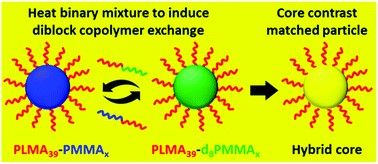This study provides an insight into the stability of such sterically-stabilised nanoparticles at high temperatures, which is important information when assessing potential applications.
As described in our surfactant explainer, surfactants can aggregate to form structures called micelles. The same is true for AB diblock copolymers, where the copolymer chains comprise two chemically distinct blocks covalently joined together, with the A and B repeat units spatially separated from each other: A-A-A-A-A-A-A-B-B-B-B-B-B.
In this neutron scattering experiment, Lubrizol scientists Dr David Growney, Dr Tim Smith and Dr Paul O'Hora collaborated with a team at the University of Sheffield, led by Professor Steve Armes and Dr Sasha Mykhaylyk to investigate how poly(lauryl methacrylate)-poly(methyl methacrylate) [PLMA-PMMA] diblock copolymer nanoparticles behaved in non-polar media when heated up to 150oC.
This team was able to conduct their time-resolved experiments by taking advantage of the differing neutron scattering properties of hydrogen and deuterium nuclei. They prepared two types of PLMA-PMMA nanoparticles, one comprising hydrogenous PMMA cores, and the other composed of deuterated PMMA cores.
On mixing these two types of nanoparticles at elevated temperature, the researchers were able to use small-angle neutron scattering (SANS) on SANS2D to observe the timescale required for copolymer chain exchange between nanoparticles. This is because such exchange leads to the formation of hybrid (mixed) nanoparticles and a significant reduction in the total neutron scattering signal as the neutron contrast for the PMMA core-forming block is progressively reduced. Now-graduated PhD student Dr Erik J. Cornel found that longer copolymer chains exchanged significantly more slowly than shorter chains.

Schematic representation of a time-resolved small-angle neutron scattering (TR-SANS) experiment in which copolymer chain exchange occurs between a binary mixture of spherical nanoparticles comprising hydrogenous and deuterated cores.
Soft Matter, 2020, Advance Article - Reproduced by permission of The Royal Society of Chemistry
The team also varied the annealing temperature from 80°C to 150°C. The rate of exchange was much faster at 150°C, indicating a strongly temperature-dependent process. According to the relevant literature, there are two possible mechanisms for copolymer exchange – chain expulsion/insertion and micelle fusion/fission. These SANS studies are consistent with the former mechanism, rather than the latter. These observations have interesting implications for polymerisation-induced self-assembly (PISA), which is a powerful platform technology for the synthesis of such block copolymer nanoparticles.
Further information
The full paper can be found at: https://doi.org/10.1039/C9SM02425E
Lubrizol accessed ISIS as part of the ISIS Collaborative R&D programme.
